#a city in central Guangdong province in China
Explore tagged Tumblr posts
Text


A city in central China sank a whopping $26 million in 2014 to build a 48-meter-tall, 1,200-metric-ton bronze statue of Guan Yu, a historical figure worshipped across East Asia and also known as the god of war. The weapon the statue held, the legendary Green Dragon Crescent Blade, alone weighs 136 metric tons. For comparison, the Statue of Liberty is 46 meters high from the top of its base to the torch, and weighs about 200 metric tons.
But the Chinese central government recently labeled the gigantic statue as an illegitimate construction, and now an additional $24 million is required to relocate it .

The theme park in Jingzhou, backed by state-run investment funds, is one of such extravagant projects that have sprung up across China. It was once hailed as a future growth driver, but it ended up incurring colossal losses.
Last year, China’s Ministry of Housing and Urban‑Rural Development issued a directive warning against the construction of gargantuan, out-of-touch statues in the name of promoting tourism or traditional culture. The ministry later named the Guan Yu statue as a violation of the rule.
It was not the first short-lived Guan Yu statue under China’s construction spree. In 2010, the southern city of Zhaoqing in Guangdong province tore down a 38-meter Guan Yu statue worth 30 million Chinese yuan ($4.6 million) after it, too, was condemned as an illegal construction.
20 notes
·
View notes
Text
Minnesota Governor Tim Walz’s elevation to the national stage as running mate for Vice President Kamala Harris has suddenly put him in the spotlight. Walz had a low national profile until a successful behind-the-scenes strategy led him to be considered for Democrats’ suddenly vacant second spot.
One of the striking elements of Walz’s biography is his unusually deep connections to China. Walz first visited the country in 1989, just months after the Tiananmen Square protests, and returned to the country some 30 times afterward. As an educator and then a small business owner, he facilitated student groups’ trips to China. As a legislator, he served on the Congressional-Executive Commission on China, which monitors human rights and the rule of law in the country, and co-sponsored resolutions urging the release of democratic activist Liu Xiaobo and remembering the Tiananmen Square victims.
Not all the attention to Walz’s China record has been positive. Republican and conservative figures have sought to portray Walz’s China ties as dangerous. On X, for example, Sen. Marco Rubio accused Walz of being a Chinese asset—“an example of how Beijing patiently grooms future American leaders”—who would “allow China to steal our jobs & factories & flood America with drugs.”
But Rubio’s attack has it precisely backward. Walz’s record is that of a measured critic of the Chinese Communist Party—prone neither to exaggeration nor accommodation. Nor is this a pose cooked up by spin doctors in the past few weeks. Small-town Nebraska newspaper articles—published well before Walz had any political ambitions—demonstrate that his professed affection for the Chinese people and culture has been matched by a longstanding criticism of the country’s rulers.
Back in the 1980s and ’90s, it didn’t take a lot to make the local papers. Walz, for instance, was once photographed for the Alliance Times-Herald—“Box Butte County’s Only Family-Owned Newspaper”—for a National Guard project: painting and repairing trash cans in the town center. (The photograph is about as exciting as the description suggests.)
The regular stuff of small-town news reporting—council meetings, 4-H club events, church announcements—was occasionally enlivened by stories about exceptional events. One such, it turned out, was Walz’s decision to teach in China as part of a program run by WorldTeach, a Massachusetts-based nonprofit. (Many news accounts, at the time and later, describe WorldTeach as a Harvard-run program, but it’s more accurate to say it was founded by Harvard students.)
“I’ve always had a real interest in travel, and feel this is a golden opportunity to see a culture that’s 3,000 years old,” Walz, then a senior at Chadron State College, told the Chadron Record in an article announcing his selection in 1989.
Walz would be going under less than glamorous conditions. It was the first year that WorldTeach would make placements in China, the Record reported, and that meant participants had to be resourceful: “They said we’ll basically have to solve our own problems,” Walz said. He said he had to raise $2,500 for his transportation, health insurance, and orientation costs—and, once in China, he would only earn $100 per month in salary (although that was, the Record noted, “about twice the amount generally paid [to] Chinese teachers”).
Although the crackdown on protesters in June 1989 led Walz to wonder whether the trip would go on, the program remained in place. After orientation in Hong Kong and Guangzhou, China, he traveled to his teaching site: a senior middle school in Foshan, a then-rapidly growing city in central Guangdong Province in southern China. There, he taught U.S. history and culture and English to classes of 65 students each from December 1989 to December 1990, according to a 1990 article in the Chadron Record. (Walz’s Midwestern-accentuated U.S. English was a change for the students, whose previous instructor was British, according to a 1994 article in the Scottsbluff Star-Herald.)
His trip was big enough news that the Record printed excerpts from a letter Walz wrote to a Chadron State faculty member while he was abroad. Walz wrote that he was “being treated like a king.” He was, he wrote, “totally responsible for my curriculum. But I’m managing.”
After he returned, Walz was invited to speak about his time at his alma mater, Chadron State. At about the same time, an interview about his year in China ran in local papers. His enthusiasm was obvious: “No matter how long I live, I’ll never be treated that well again,” Walz told the Record in 1990. “They gave me more gifts than I could bring home. It was an excellent experience.” (In 2024, the New York Post twisted this line as evidence that Walz had “fawned over Communist China.”)
Yet in context, it’s clear that Walz was no dupe. During his teaching year, he visited Beijing (a 40-hour trip by rail) and saw Tiananmen Square, according to the Record. As much as Walz loved China and the Chinese people, his attitude toward the Chinese Communist Party was bluntly critical. Tiananmen Square, he told the Record, “will always have a lot of bitter memories for the people.” (Walz later chose June 6 as his wedding date so he could “have a date he’ll always remember,” according to his wife.)
The problem with China, Walz observed, wasn’t its people but the government. “If they had the proper leadership, there are no limits on what [Chinese people] could accomplish,” he told the Record. “They are such kind, generous, capable people. They just gave and gave and gave to me. Going there was one of the best things I have ever done.”
Walz viewed China’s population as eager to leave its Communist-run society. “Many of the students want to come to America to study,” he told the Record. “They don’t feel there is much opportunity for them in China.” He mentioned that during one of his trips to nearby Macau, then still a Portuguese colony, the government granted amnesty to Chinese immigrants living in the colony illegally, triggering a stampede by tens of thousands of Chinese who wanted residency in the West.
The trip shaped Walz’s career as an educator. Within a few months of his return, Walz had found a job as a social studies teacher in Alliance, Nebraska, a town whose population was then just under 10,000 people. He created a pen-pal program linking his students to Chinese middle-school students at his old teaching placement, where a friend of his worked. The program was reported on the front page of the Alliance Times-Herald in 1991.
Walz, who must have been a dynamic teacher, used the exchange of letters to not only bridge cultural gaps but also demonstrate the stakes of then-acrimonious U.S.-China government relations to his students. Walz pointedly described the politics of the countries’ then-seemingly large trade imbalance (a fraction of what it is now) to the Times-Herald: “The Chinese government wants us to buy what they sell, but won’t buy what we sell.”
Soon, Walz was leading groups of students to China. The first visit was in July 1993, when he took 25 Alliance High School students on a trip partly funded by the Chinese government, although the students and sponsors, including Walz, had to cover costs of $1,580 each, according to an article in the Scottsbluff Star-Herald; Walz helped by raising funds from local businesses. (In a rare criticism of an aspect of Chinese culture, rather than the Chinese Communist Party, Walz responded to one student’s interest in hearing Chinese opera by saying he’d “rather eat glass” than see another Chinese opera.) Walz’s honeymoon with his wife, a fellow teacher, the next year involved two student trips to China, according to the Star-Herald. Later, he and his wife would start a business to promote similar exchanges.
For all his fondness toward China, Walz’s descriptions of its people at times reflected the prevailing stereotypes of the time. “The students are almost too well behaved,” he wrote in his letter from China that was excerpted in the Record in 1989. In a 1994 profile ahead of his honeymoon in China, Walz told the Star-Herald that it had been hard to memorize names and tell his students apart (although he also noted that Chinese students thought all Americans looked alike.) To the Times-Herald in 1993, he described his students as not overly creative but industrious: “[T]here was never even any unfinished homework,” he recalled. And, for Walz, mostly used to small-town life, the sheer scale of China was astonishing: “The people were the best part, and the worst part was the number of people.”
The contemporaneous (and surprisingly extensive) record of how Walz’s time in China influenced him clearly rejects the idea that Walz was groomed or otherwise misled by his time in the country. He was an earnest, young observer of a society and government radically unlike his own. After repeated exposure, however, China became increasingly familiar to him. His opinions about the Chinese people and their government derived from firsthand observations, filtered through his own background and reading.
Neither a hawk nor a dove, Walz approached China as a student and a teacher—an owl, to steal a metaphor. Throughout these early interviews, his insistence on the separation between a people and their government—and his repeated criticism of the Chinese government—was plain. So was his emphasis on the importance of democracy and recognizing where the United States fell short.
People change, and seeking clues to how a potential Vice President Walz would act based on how high school teacher Walz approached his lessons is clearly perilous. Still, it seems clear that Walz values facts, and in particular experience, rather than theory or ideology; that he has deeply held core beliefs about China’s people and government set in the era of Tiananmen; and that his commitment to promoting human rights—and U.S. economic interests in trade negotiations—is longstanding.
With that background, leavened by subsequent experience on China issues as a member of Congress, it seems more likely than not that Walz would be neither inflexibly hostile nor naïve about relations with Beijing.
16 notes
·
View notes
Text
Our country's regional visa-free policy for foreigners mainly includes:
Hong Kong and Macao foreign tour groups to enter Guangdong 144-hour visa-free policy. Citizens of countries with diplomatic ties with China holding ordinary passports may visit the nine cities in the Greater Bay area and the Shantou Bay Area without the need for a visa after entering the region through a group of Hong Kong and macao-registered travel agents, activities will be held in the cities of Guangzhou, Foshan, Zhaoqing, Shenzhen, Dongguan, Huizhou, Zhuhai, Zhongshan, Jiangmen and Shantou, group in and out, stay less than 144 hours.
Visa-free entry policy for tour groups from ASEAN countries to Guilin, Guangxi. Group tours (2 or more) from ASEAN countries (Malaysia, Indonesia, Thailand, Philippines, Singapore, Brunei Darussalam, Vietnam, Laos, Myanmar, Cambodia) , with an ordinary passport, you can enter or leave the country visa-free through the Guilin Airport and travel agencies in Guilin, stay no longer than 144 hours.
Visa-free entry policy for foreign tour groups by cruise. Foreign tour groups (2 or more persons) on cruises and received by travel agencies in China, visa-free group visits are available from 13 cruise ports in Tianjin, Dalian, Shanghai, Lianyungang, Wenzhou and Zhoushan, Xiamen, Qingdao, Beihai, Haikou and Sanya, the tour group shall travel with the same cruise to the next port until the departure of this cruise, activities for Tianjin, Hebei, Liaoning, Shanghai, Jiangsu, Zhejiang, Fujian, Shandong, Guangdong, Guangxi, Hainan and other 11 coastal provinces (autonomous regions, municipalities directly under the central government) and Beijing, stay no longer than 15 days.
4th, 59 countries personnel entry Hainan 30 days visa-free policy. Russia, the United Kingdom, France, Germany, Norway, Ukraine, Italy, Austria, Finland, the Netherlands, Denmark, Switzerland, Sweden, Spain, Belgium, the Czech Republic, Estonia, Greece, Hungary, Iceland, Latvia, Lithuania, Luxembourg, Malta, Poland, Portugal, Slovakia, Slovenia, Ireland, Cyprus, Bulgaria, Romania, Serbia, Croatia, Bosnia and Herzegovina, Montenegro, North Macedonia, Albania, the United States, Canada, Brazil, Mexico, Argentina, Chile, Australia, New Zealand, South Korea, Japan, Singapore, Malaysia, Thailand, Kazakhstan, the Philippines, Indonesia, Brunei, the United Arab Emirates, Qatar, Monaco, Belarus and 59 other countries hold ordinary passports, for short-term reasons such as tourism, business, visit, family visit, medical treatment, convention and exhibition, sports competition, etc. (except for work and study reasons) , visa-free entry to Hainan may be granted, the scope of activities shall be within the administrative area of Hainan province, and the entry and exit ports shall be all open ports of Hainan province, and the stay time shall not exceed 30 days.
Visa-free 144-hour entry policy for foreign tour groups from Hong Kong and Macao. Citizens of countries with diplomatic relations with China who hold ordinary passports and visit Hong Kong and Macao may visit Hainan visa-free if they are in a group of two or more members of a travel agency legally registered in Hong Kong and Macao, activities for the administrative area of Hainan province, the entry and exit ports for all open ports in Hainan province, the use of group entry and exit mode, stay less than 144 hours.
4 notes
·
View notes
Text
4 Dead, 60 Injured As "Strongest Earthquake In 25 Years" Hits Taiwan
At least four people were killed and nearly 60 injured Wednesday by a powerful earthquake in Taiwan that damaged dozens of buildings and prompted tsunami warnings that extended to Japan and the Philippines before being lifted.

Officials said the quake was the strongest to shake the island in decades, and warned of more tremors in the days ahead.
"The earthquake is close to land and it's shallow. It's felt all over Taiwan and offshore islands," said Wu Chien-fu, director of Taipei's Central Weather Administration's Seismology Center.
Strict building regulations and disaster awareness appear to have staved off a major catastrophe for the island, which is regularly hit by earthquakes as it lies near the junction of two tectonic plates.
Wu said the quake was the strongest since a 7.6-magnitude struck in September 1999, killing around 2,400 people in the deadliest natural disaster in the island's history.
Wednesday's magnitude-7.4 quake struck just before 8:00 am local time (0000 GMT), with the United States Geological Survey (USGS) putting the epicentre 18 kilometres (11 miles) south of Taiwan's Hualien City, at a depth of 34.8 kilometres.
Three people among a group of seven on an early-morning hike through the hills that surround the city were crushed to death by boulders loosened by the earthquake, officials said.
Separately, a truck driver died when his vehicle was hit by a landslide as it approached a tunnel in the area.
Social media was awash with shared video and images from around the country of buildings swaying as the quake struck.
"I wanted to run out, but I wasn't dressed. That was so strong," said Kelvin Hwang, a guest at a hotel in the capital, Taipei, who sought shelter in the lift lobby on the ninth floor.
Dramatic images were shown on local TV of multi-storey structures in Hualien and elsewhere tilting after it ended, while a warehouse in New Taipei City crumbled.
Local TV channels showed bulldozers clearing rocks along roads to Hualien, a mountain-ringed coastal city of around 100,000 people that was cut off by landslides.
President Tsai Ing-wen called for local and central government agencies to coordinate with each other, and said that the national army would also be providing support.
The National Fire Agency confirmed the death toll, adding nearly 60 people had been treated for quake-related injuries.
Regional impact - In Taiwan, Japan and the Philippines, authorities initially issued a tsunami warning but by around 10 am (0200 GMT), the Pacific Tsunami Warning Center said the threat had "largely passed".
In the capital, the metro briefly stopped running but resumed within an hour, while residents received warnings from their local borough chiefs to check for any gas leaks.
Taiwan is regularly hit by earthquakes as the island lies near the junction of two tectonic plates, while nearby Japan experiences around 1,500 jolts every year.
Across the Taiwan Strait, social media users in China's eastern Fujian province, which borders Guangdong in the south, and elsewhere said they also felt strong tremors.
Residents of Hong Kong also reported feeling the earthquake.
China, which claims self-ruled Taiwan as a renegade province, was "paying close attention" to the quake and "willing to provide disaster relief assistance", state news agency Xinhua said.
Fabrication at Taiwan Semiconductor Manufacturing Company -- the world's biggest chip maker -- was briefly interrupted at some plants, a company official told AFP, while work at construction sites for new plants was halted for the day.
The vast majority of quakes around the area are mild, although the damage they cause varies according to the depth of the epicentre below the Earth's surface and its location.
The severity of tsunamis -- vast and potentially destructive series of waves that can move at hundreds of kilometres per hour -- also depends on multiple factors.
Japan's biggest earthquake on record was a massive 9.0-magnitude undersea jolt in March 2011 off Japan's northeast coast, which triggered a tsunami that left around 18,500 people dead or missing.
The 2011 catastrophe also sent three reactors into meltdown at the Fukushima nuclear plant, causing Japan's worst post-war disaster and the most serious nuclear accident since Chernobyl.
Japan saw a major quake on New Year's Day this year, when a 7.5-magnitude tremor hit the Noto Peninsula and killed more than 230 people, many of them when older buildings collapsed.
8 notes
·
View notes
Video
youtube
Sourcing Furniture from Foshan China, LongJiang Furniture Manufacturer
Foshan is a prefecture-level city in central Guangdong province, People's Republic of China. The click here city has jurisdiction over an area of about 3,840 km² and a population of 5.4 million of which 1.1 million reside in the city proper (year 2000 figures).
Foshan is China's largest furniture manufacturer Center. there are about 2,800 manufacturers there, producing all kinds of furniture for indoor, outdoor and office use. This does not include the hardware and component suppliers.
Shunde and Nanhai are the two main districts in Foshan that house these seemingly endless stretch of Furniture suppliers..
Shunde, China Furniture Wholesale Market is located at Shunde district which links Lecong town and Longjiang town along the 10 km highway. Guangdong Province, China. Shunde has become the largest furniture wholesale market and distribution center in China and the world. It claims to be the The World Largest Furniture Wholesale Market. It was named as the China Furniture Business and Trading Capital by the China National Light Industry Council and China National Furniture Association. It covers a total area of approximately 32.3 million square feet (3 million square meter) and it includes more than 200 modern furniture sales buildings, such as Sunlink Group, Lecong International Furniture Exhibition Center, Shunde Empire Group, Tuanyi International Furniture City, and others.
The furniture wholesale market extends more than 5 km and is arranged by 12 rows and 20 streets. There are over 3,300 domestic and foreign furniture dealers and more than 1,500 furniture manufacturers. Jointly they display over 20,000 types of furniture and products ranging from living room furniture, dining room furniture, bedroom furniture, kitchen furniture, hotel furniture, hotel mattress, contract furniture, restaurant furniture, cafe chairs, bar stools, bathroom furniture, sanitary ware, furniture accessories, material & hardware. The market is open year round with furniture trading more than USD1 billion sales volume each year.
2 notes
·
View notes
Text
Hong Kong, Shenzhen deluged by heaviest rain on record, 83 hurt
Sept. 7, 2023 - Reuters
The Asian financial hub of Hong Kong was drenched on Friday by the heaviest rain since records began 140 years ago, with 83 people hurt, three seriously, as unusually wet weather caused by typhoons brought more disruption to southern China.
Videos showed cascades of water surging down steep hillsides in the former British colony, flooding waist-deep in narrow streets, and inundating malls, metro stations and tunnels.
The extreme weather also brought chaos to the nearby Chinese city of Shenzhen, a tech hub of more than 17.7 million people, with business and transport links across the economically important Pearl River Delta severely hit.
The torrential rain was brought by Haikui, a typhoon that made landfall in the Chinese province of Fujian on Tuesday. Although it weakened to a tropical depression its slow-moving clouds have dumped huge volumes of precipitation on areas still soaked by rain from a super typhoon a week earlier.
Hong Kong's weather bureau issued its highest "black" rainstorm warning, and said more than 200 mm (7.9 inches) of rain was recorded on Hong Kong's main island, the Kowloon district and the northeastern part of the city's New Territories from late on Thursday...
The China Meteorological Administration said heavy rain would fall until early Saturday on the central and southwestern areas of Guangdong province...
A rainfall log showed 465.5 mm (1.5 ft) of rain fell in Shenzhen over a 12-hour period, the highest since records began in 1952...
#orgone#orgone energy#orgonite#orgonite gifting#hong kong#rain#flooding#typhoon#record rainfall#planetary healing#weather#climate#climate change#geo-restoration#free energy#china
4 notes
·
View notes
Text
China's visa-free policy is fully relaxed
For foreigners, China's "144-hour visa-free" policy is very convenient. This policy applies to citizens of 54 countries. As long as they hold a connecting flight ticket to a third country, they can stay in a visa-free city for six days without complicated visa procedures. This surprised many foreigners - it was originally just a short transit, but they didn't expect to be able to "check in" in a Chinese city. This simple and convenient "transit tour" has become the first choice for many foreigners.
The National Immigration Administration issued an announcement today, comprehensively relaxing and optimizing the transit visa-free policy from now on, extending the stay time of foreigners in transit visa-free from the original 72 hours and 144 hours to 240 hours (10 days), and adding 21 ports as entry and exit ports for transit visa-free personnel, and further expanding the stay and activity area. Eligible people from 54 countries including Russia, Brazil, the United Kingdom, the United States, and Canada, who transit from China to a third country (region), can come to China visa-free from any of the 60 open ports in 24 provinces (autonomous regions and municipalities), and stay in the specified area for no more than 240 hours.
The 21 newly added ports for the relaxation and optimization of the transit visa exemption policy include: Shanxi Taiyuan Wusu International Airport, Jiangsu Suonan Shuofang and Yangzhou Taizhou International Airport, Zhejiang Wenzhou Longwan and Yiwu International Airport, Anhui Hefei Xinqiao and Huangshan Tunxi International Airport, Fujian Fuzhou Changle, Quanzhou Jinjiang and Wuyishan International Airport, Jiangxi Nanchang Changbei International Airport, Shandong Jinan Yaoqiang, Yantai Penglai and Weihai Dashuibo International Airport, Hunan Zhangjiajie Hehua International Airport, Guangxi Nanning Wuxu and Beihai Fucheng International Airport, Hainan Haikou Meilan and Sanya Phoenix International Airport, Sichuan Chengdu Tianfu International Airport, Guizhou Guiyang Longdongbao International Airport. The number of ports open to the outside world has increased from the original 39 to 60.
The fully relaxed and optimized 240-hour transit visa exemption policy has further expanded the stay and activity area. The policy applies to 19 provinces (autonomous regions and municipalities) including Beijing, Tianjin, Hebei, Liaoning, Heilongjiang, Shanghai, Jiangsu, Zhejiang, Fujian, Shandong, Henan, Hubei, Hunan, Guangdong, Guangxi, Chongqing, Sichuan, Yunnan and Shaanxi, with the addition of 5 provinces (Shanxi, Anhui, Jiangxi, Hainan and Guizhou), totaling 24 provinces (autonomous regions and municipalities). Among the newly added 5 provinces, the stay and activity areas for transit visa-free personnel in Anhui, Hainan and Guizhou are the entire province, the stay and activity areas in Shanxi are Taiyuan and Datong, and the stay and activity areas in Jiangxi are Nanchang and Jingdezhen. The stay and activity areas in Fujian, Hubei and Shaanxi are expanded to the entire province, and the stay and activity areas in Guangxi Zhuang Autonomous Region are expanded to the administrative areas of 12 cities including Nanning, Liuzhou, Guilin, Wuzhou, Beihai, Fangchenggang, Qinzhou, Guigang, Yulin, Hezhou, Hechi and Laibin. Foreigners coming to China through the transit visa-free policy can travel across provinces within the permitted stay and activity areas in the above 24 provinces (autonomous regions and municipalities).
The relevant person in charge of the National Immigration Administration introduced that the relaxation and optimization of the transit visa exemption policy is an important measure for the National Immigration Administration to earnestly study and implement the spirit of the Central Economic Work Conference, actively and positively serve to promote high-level opening up, and facilitate exchanges between Chinese and foreign personnel. It is conducive to accelerating the cross-border flow of personnel, promoting foreign exchanges and cooperation, and injecting new impetus into the high-quality development of the economy and society. In the next step, the National Immigration Administration will continue to deepen the institutional opening of immigration management, continuously optimize and improve immigration entry and exit facilitation policies, and continuously improve the convenience of foreigners studying, working, and living in China. We welcome more foreign friends to come to China and experience the beauty of China in the new era.
1 note
·
View note
Text
Winds of Change
3 March 1980
At the recent Party internal Beidaihe meeting, Deng Xiaoping announced that he would begin steering the nation into a new position: focusing on light industry and rolling out the new Household Responsibility System
However, this shift has not been without its critics. “Without the heavy industry, where will your steel come from? Where will your oil come from? How can the nation sustain its industrial backbone or even ensure basic necessities such as food?” said an exasperated Conservative.
“Why can my aunt in Henan earn so much more than I can? Research and Development funds are directed towards cities, labour mobility restrictions have been eased to benefit urban populations, and yet I am unable to find work in cities because the nation thinks I am defined by where I was born, and not my ability.” said another angry farmer. All eyes are on the Central Committee and their methods of resolving this rural-urban divide as they convene to lead China into a new age of reform.
The discussions are particularly loud in Guangdong, a province that is still undergoing economic development. "When will I be allowed to go to Shenzhen?" Cries a concerned resident. It seems whoever can formulate better plans for the economic future of Guangdong stands to gain significant influence and power within the provincial government.
0 notes
Text
Nationwide Push for Two-Wheeler Market Rectification | Accelerating the Standardization of "Swap Instead of Charge"
In the past two years, numerous regions across China have embarked on an extensive campaign to clean up the electric two-wheeler market, aiming to eliminate chaos and irregularities. Among these initiatives, battery exchange cabinet model, with its safety and convenience benefits, has emerged as a targeted solution to combat illegal modifications and substandard lithium batteries, ushering in a compliant development opportunity.

At the heart of this model lies the smart battery swapping cabinet, whose promotion and adoption are set to significantly propel this process forward. However, given the complexities of urban infrastructure, planning, and administrative considerations, the widespread adoption of battery swapping cannot be achieved overnight.
The appeal of the swapping model lies in its centralized management of electric two-wheeler batteries, effectively reducing fire safety hazards and curbing illegal tampering.

Yet, the promotion of battery swapping faces hurdles. Its success hinges on the use of compliant lithium batteries, but most currently on the market fall short of national standards, posing severe safety risks.
To address this, the country has mandated compulsory standards for electric bicycle lithium batteries, with some battery enterprises already certified. Moreover, standards for electric motorcycles and light electric motorcycles are under rapid revision.
To further accelerate the "swap instead of charge" transition, a unified group standard for public charging and swapping facilities for electric bicycles is being formulated. This standard will encompass key equipment such as charging cabinets, swapping cabinets, and swapping batteries, enjoying the active participation and collaboration of 10 major provinces and cities including Beijing, Shanghai, Guangdong, Guangzhou, Shenzhen, and Nanjing.
Looking ahead, with the introduction of relevant regulations and industry standards, the battery swapping model is poised to gradually evolve towards compliance and standardization.
0 notes
Text
Two Sessions 2024|Zhaoqing Mayor Xu Xiaoxiong: Developing new productive forces will stand up the backbone of Zhaoqing’s manufacturing industry
By Sun Lei Hong Kong Economic Herald

Standing on a new journey, how can Zhaoqing accelerate the development of new productive forces, plan and layout industrial development, and make the manufacturing industry bigger and stronger? During the National Two Sessions, the reporter interviewed Xu Xiaoxiong, deputy to the National People’s Congress and mayor of Zhaoqing.
Reporter: How has Zhaoqing implemented the relevant deployment requirements of the central government and Guangdong in recent years and unswervingly expanded and strengthened its manufacturing industry? What results have been achieved?
Xu Xiaoxiong: Manufacturing has always been Guangdong’s deep “industry” and the foundation for Guangdong’s high-quality development. Guangdong insists on focusing on the manufacturing industry and strengthening and optimizing the real economy. It has successively issued relevant policies and measures such as the “Opinions of the Guangdong Provincial Committee of the Communist Party of China on Building a Strong Manufacturing Province with High Quality”, once again clarifying the important strategic position of the manufacturing industry.
Since the “14th Five-Year Plan”, we have fully implemented the deployment requirements of the central and provincial governments on promoting high-quality development of the manufacturing industry, adhered to the real economy as the basis and the manufacturing industry as the leader, vigorously implemented the “Ten Actions” for the manufacturing industry, and strived to create new energy Automobiles and new energy storage are two 100-billion industry clusters. The main practices and results are:
First, continue to strengthen the clear orientation of large-scale industrial investment. Focusing on advanced manufacturing, we have held more than 120 large-scale investment promotion events such as the Zhaoqing Global Investment Conference since last year, matched with more than 3,000 enterprises, and planned to invest more than 100 billion yuan in the introduction of manufacturing projects. We launched a manufacturing project construction campaign and completed nearly 10,000 acres of “cooked land” for industrial use. Industrial investment increased by more than 20%, maintaining double-digit growth for three consecutive years, and promoted the realization of 172 new manufacturing projects that were started and completed throughout the year. 175 units and 127 units were put into production. At the same time, the industry chain orientation and innovation capability orientation are strengthened. Among the newly introduced manufacturing projects, high-tech enterprises and specialized and new “little giant” enterprises account for more than 40%.
The second is to continue to promote the agglomeration of emerging industries. The total output value of the three emerging industries of new energy vehicles, new energy storage, and electronic information has increased by 1.82 times in the past four years, reaching 167.5 billion yuan. In terms of the new energy vehicle industry, Zhaoqing has become an important city in the province’s new energy vehicle industry and has been included in the province’s “14th Five-Year Plan”. There are nearly a hundred regulated companies, covering complete vehicles, power batteries, motors and electronic controls, chassis and In fields such as lightweighting, the industrial output value exceeded 80 billion last year. In terms of the new energy storage industry, Zhaoqing has carried out all-round strategic cooperation with “chain master” companies such as CATL, and major projects such as Putilai and GCL have successively settled. The output of energy storage lithium batteries accounts for 1/6 of the country’s total, and a chemical storage industry has initially formed. The energy-based manufacturing industry ecology has been listed as a key city for energy storage industry agglomeration on the west bank of the Pearl River Estuary, with an industrial output value of nearly 50 billion yuan in 2023. In terms of electronic information, Fenghua Hi-Tech has been listed as the “chain master” enterprise in the key industrial chain of the provincial strategic industrial cluster. Leading projects such as Xizhen Circuit and Guanxu Electronics have been put into production and construction. Zhaoqing has become the center for R&D, production and development of new components and basic electronic information products. Export base. Since the beginning of this year, we have successively promoted the settlement of the South China headquarters and hydrogen fuel cell R&D and production base projects of Hydrogen Lan Technology, and the start of the west park of the Xpeng Intelligent Automotive Parts Industrial Park. We are also among the top 100 cities for foreign trade in China and the top 100 cities for advanced manufacturing in the country, which shows that Zhaoqing’s advanced manufacturing industry already has a certain industrial scale and influence.
The third is to continue to promote the accelerated transformation and upgrading of traditional industries. We regard the promotion of industrial technological transformation as the key to maintaining the vitality of the manufacturing industry. Last year, the city completed an investment of more than 20 billion yuan in industrial technological transformation, growing rapidly for many consecutive years. It was approved to implement the provincial pilot city for digital transformation of small and medium-sized enterprises, and a total of 691 enterprises above designated standards were promoted to implement digital transformation. Gaoyao Intelligent Hardware, Sihui Polymer Synthetic Materials, etc. have become national and provincial characteristic industrial clusters of small and medium-sized enterprises, and the recycling transformation of 6 parks has passed provincial and above acceptance.
Reporter: Based on promoting the deep integration of industrial digitalization, intelligence and greening, from the two dimensions of industrial layout and park layout, how does Zhaoqing plan to develop the manufacturing industry in the future and deeply embed it in the Greater Bay Area industrial chain?
Xu Xiaoxiong: From the perspective of industrial layout, we focus on connecting with 20 strategic industrial clusters in Guangdong Province, focusing on developing and expanding “leading + characteristic” industries, aiming at future industries to explore new breakthroughs, and strive to achieve the city’s industrial investment of over 100 billion yuan this year, new energy The output value of the automobile industry exceeds 100 billion yuan, and the formation of three 100-billion-level industrial clusters including new energy vehicles, new energy storage, and metal processing is accelerating. The main path and key starting point is to be deeply embedded in Guangdong Province’s trillion-level industrial clusters, deepen supporting cooperation with hundreds of billions-level leading enterprises, and strive to find Zhaoqing’s position among them. In terms of leading industries, it participates in the provincial auto parts industry strong chain project, supports local auto parts companies to integrate into the supply chain systems of chain owners such as BYD, GAC, and Xpeng, and forms a collaborative pattern with the new energy vehicle industry ecology in central cities. Focusing on the joint construction of the energy storage battery industry cluster on the west bank of the Pearl River Estuary, we will introduce chain extension and chain reinforcement projects such as the construction of energy storage equipment, positive (negative) electrode materials, and battery recycling, and build an advanced manufacturing base. Promote the electronic information industry to participate in the upstream and downstream supporting industry chains on the east bank of the Pearl River, and build a new electronic components cluster. In terms of featured industries, focusing on the needs of the industrial chain and supply chain in the Greater Bay Area, we will promote the transformation and development of new materials into front-end material applications in emerging industries, accelerate the transformation and upgrading of industries such as metal processing, green building materials, food and beverages, and form a tiered development and strong supporting industry. 100-billion-yuan and 100-billion-yuan characteristic industrial clusters.
From the perspective of park layout, we have accelerated the construction of the city’s “344” park development pattern and proactively taken over various industries and innovative resource elements in the Greater Bay Area. Promote the contiguous development of the three major industrial development core parks of Guangdong Province (Zhaoqing), Zhaoqing High-tech Zone, and Zhaoqing New District, integrate the industrial layout of central cities in the Greater Bay Area, and create a “10,000-acre, 100-billion-dollar” industrial development platform. Taking the municipal management area of a large industrial agglomeration area in Guangdong Province (Zhaoqing) as an example, it takes an average of 3.8 days to introduce a project here, and an average of 8 days for a project to realize land supply and start construction, showing a vigorous momentum of the main platform and the main battlefield. Promote the differentiated development of characteristic parks in the four districts (cities) in the eastern sector and the four counties in the western sector, and actively undertake the transfer of high-quality industries from central cities in the Greater Bay Area. Scientifically and rationally build an industrial park development pattern of “one county, one park, one characteristic”, such as Duanzhou Electronic Components Park, Sihui Fine Chemical Park, Gaoyao Auto Parts Park, Huaiji Food Processing Industrial Park, Deqing Fan Equipment Park, etc. Provide high-quality space conditions for the orderly transfer of industries in the Greater Bay Area. Promote the overall quality and efficiency improvement of industrial parks. The infrastructure of the industrial parks in the 4 districts (cities) in the eastern sector has reached the “nine connections and one leveling” standard, and the 4 counties in the western sector have reached the “eight connections and one leveling” standard. At the same time, the entry threshold for the park has been strictly controlled, and indicators such as the average output per mu of the park have been continuously improved, striving to By 2025, the city’s total industrial output value will be close to 500 billion yuan.
Reporter: At this year’s National Two Sessions, new productivity has become a high-frequency word in local plans. How does Zhaoqing develop new productivity and promote high-quality development of the manufacturing industry?
Xu Xiaoxiong: On the one hand, we take technological innovation as the guide and coordinate the promotion of the upgrading of traditional industries, the growth of emerging industries, and the cultivation of future industries. Maintain sensitivity and attention to cutting-edge technologies, lay out the industrial chain around the development of new productive forces, and stand up the “backbone” of Zhaoqing’s manufacturing industry. The first is to deeply connect with the Guangzhou-Shenzhen-Hong Kong-Macao Science and Technology Innovation Corridor and build Zhaoqing into a regional carrier for accelerating industrialization. Build platform carriers such as Zhaoqing National High-tech Zone, improve the laboratory system led by Xijiang Laboratory and Fenghua High-Tech State Key Laboratory, and build a whole-process innovation chain of “basic research + technological research + achievement transformation + science and technology finance + talent support” , Promote the implementation and transformation of various innovative achievements. The second is to adhere to green development and digital transformation, and transform and upgrade traditional advantageous industries. Pay close attention to the technological transformation and product iterative upgrading of metal processing, green building materials, food and beverage and other industries, seize new tracks such as laser manufacturing, micro-nano manufacturing, additive manufacturing, lightweight materials, new building materials, etc., and promote the agglomeration of the food and beverage prepared dish industry to develop in an all-round way and open up channels for the industrialization and branding of “local specialties”. The third is to continue to cultivate and expand emerging industries and create a new development pattern of “two new and one electricity”. Accelerate the construction of Xpeng Motors’ new model projects, promote the construction of Zhaoqing Dawang Intelligent Connected New Energy Vehicle Industrial Park and Zhaoqing (Gaoyao) Auto Parts Industrial Park, and promote the “trinity” of complete vehicles, parts and aftermarkets. Focus on electrochemical energy storage, deepen strategic cooperation with CATL, Shenzhen Energy, etc., fully promote the construction of projects such as Ruiqing Times, GCL, Putilai, Jinsheng, etc., and strive to reach a new level in the new energy storage industry this year. Last year, we completed and launched the province’s first commercially operated grid-side independent energy storage power station — Wanliyang Duanzhou Independent Energy Storage Power Station, opening the door for capital operation of independent energy storage power stations. Make the electronic information industry bigger and stronger, relying on platforms such as Zhaoqing New District Electronic Information Industrial Park and Zhaoqing (Sihui) Electronic Information Industrial Park, focusing on the development of electronic components, new displays, automotive electronics, consumer electronics and other industries, and accelerating the second phase of Guanxu , Xizhen Phase II, Virginie and other projects are under construction to create an electronic information industry cluster worth over 50 billion yuan. The fourth is to lay out and build future industries and open up new space for the manufacturing industry. We will make forward-looking plans and explore appropriate entry into future industries such as hydrogen energy, low-altitude economy, robotics, and artificial intelligence, and use demonstration applications to drive the initial development of the industry.
On the other hand, we will accelerate the promotion of green development. Green development is an intrinsic requirement for accelerating the cultivation of new productive forces. In recent years, we have accelerated the adjustment of industry, energy and other structures. Last year, Zhaoqing High-tech Zone became one of the first 10 carbon peak pilot parks in the country, and Ruiqing Times ranked among the “zero-carbon factories”. Next, we will aim to build a low-carbon city, steadily promote “dual carbon” work, actively build a number of “green low-carbon factories”, and fully promote the green transformation and development of industries. We will build high-quality green energy bases, solidly advance projects such as pumped hydro energy storage, integrated wind and solar energy storage, and distributed photovoltaics, and promote the deep integration of green power resources and manufacturing. Accelerate green technological innovation and the promotion and application of advanced green technologies, accelerate the green transformation of building materials, hardware, papermaking and other industries, and strengthen energy-saving and environmental protection equipment.
0 notes
Text
Chinese modernization is a great feat unprecedented in history: Italian scholar
City view of Guangzhou, South China’s Guangdong Province Photo: VCG Editor’s Notes:Chinese President Xi Jinping stressed the importance of correctly understanding and vigorously advancing Chinese modernization while addressing the opening of a study session at the Party School of the CPC Central Committee (National Academy of Governance) earlier this month. Xi said Chinese modernization is a new…

View On WordPress
0 notes
Text
A knockout success in TV drama highlights a trend toward realism
A knockout success in TV drama highlights a trend toward realism
Television viewers were surprised recently when Su Xiaoding, Lin Jiachuan and four other actors who play villains in the TV series "The Knockout" begged the pardon of fans and said they really weren't bad guys in real life.To get more news about the knockout chinese drama, you can visit shine news official website.
That they seemed so real on screen is testament to some of the grittier fare on television, where series are focusing more on real life, both historical and contemporary, and attracting enthusiastic audiences.
"The Knockout" is rooted in China's national campaign to crack down on gang crime. Some viewers have even suggested, tongue in cheek, that police "investigate" actor Zhang Songwen, who plays criminal lord Gao Qiqiang in the series so realistically that it seems he's not acting at all.
Gao's favorite book in the series, "The Art of War" by ancient Chinese war strategist Sun Tzu, has enjoyed a surge in sales with the overwhelming popularity of the series.Young people seem drawn to drama that is a stark contrast to the once commonplace boring, insipid TV fare.
"My classmates and I have really enjoyed the new drama, which is a big departure from the normal, mainstream stuff," said college student Chris Yu. "The storytelling is creative, with its overlapping timelines and flashbacks, and all the characters are multifaceted and interesting."
The 39-episode "The Knockout" began airing on China Central Television and iQiyi last month. It was simultaneously released overseas in subtitles of eight languages for viewers in North America, Europe and Southeast Asia.
Inspired by true events, the drama centers on two decades of interaction between a gang boss and a police officer that began when the gangster was a humble fishmonger and a friend of the cop. However, they finally become foes, and the drama follows their years of cat-and-mouse struggle.
Through varied timelines, the drama is set against the backdrop of China's tremendous social transformation and progress in legal reforms.The series is apparently popular overseas as well. Rickshaw drivers in Thailand have been known to play excerpts of "The Knockout" and its theme song, trying to attract the business of Chinese tourists. On some websites in Japan, the drama is also a trending search topic.
The iQiyi Research Center said the show has broken a two-year popularity record previously held by the comedy costume drama "My Heroic Husband." "The Knockout" is also the most-watched drama on CCTV Channel 8.
On the leading film and TV review website Douban, more than 600,000 viewers give the series an 8.5 out of 10 rating.
The series is shot on location in the city of Jiangmen in Guangdong Province, which is also attracting visitors eager to sample local delicacies such as rice rolls and pig's-feet noodles that are featured in the drama.Industry professionals are closely watching the success of the drama and contemplating its repercussions, both for television and for spill-over effects such as tourism.
Dai Ying, senior vice president at iQiyi, said that the drama sets the bar higher for production of high-quality contents in the genre.
The production team spent three years on the series. Director and scriptwriter Xu Jizhou said in a media interview that "The Knockout" is not simply a story about fighting crime, but also a reflection of social evolution this century.
"We needed to do a lot of interviews and research to recreate the realism of the era," director Xu said. "Audience can obviously see the changes of sets, makeup, costumes and props that reflect changing styles over the years."
1 note
·
View note
Text
LWK + PARTNERS Architects, Hong Kong
LWK + PARTNERS Architects, Building, HK Design Studio Images, Architecture Office China
LWK + PARTNERS Hong Kong Architects
Contemporary HK Architect Practice – Chinese Design Studio Info + News
post updated 24 September 2021
LWK + PARTNERS Architects News
24 Sep 2021 Two LWK + PARTNERS projects earn esteemed recognitions at The Global RLI Awards 2021
LWK + PARTNERS is pleased to announce that two of the firm’s design projects in China won distinguished acclaims at world-renowned The Global RLI Awards 2021. The awards were announced in a hybrid presentation ceremony held in London on 23 September.
Zijing Paradise Walk, Hangzhou, China • RLI Most Innovative Retail & Entertainment Project (Highly Commended)
Designed with culture and wellness themes, this shopping mall freshens up the local retail scene with playful references to village life, Hui-style architecture and traditional Chinese gardens. Not only is the building aesthetically pleasing, but it also provides cool shades for passers-by with shifting and cantilevered forms.
image courtesy of architects Zijing Paradise Walk, Hangzhou
MixC Dongguan Songshan Lake District Mixed Use Development, Dongguan, China • RLI Future Project (Highly Commended)
The project is conceived as a catalyst of urban transformation turning a sub-urban industrial landscape to a robust lifestyle and cultural hub. Featuring diverse energising public spaces and multifarious greenery, the project also benefits the community with premium apartments and commercial facilities.
Ferdinand Cheung, Director of LWK + PARTNERS, joined the ceremony online and noted: “I would like to thank RLI and the jury for the recognition. Credits to the team for their continuous efforts through the challenges in both projects. We also look forward to the completion of the MixC project in Dongguan.”
The Global RLI Awards celebrates the most visionary and innovative retail and leisure concepts from across the globe. Since its inception 16 years ago, it has been regarded as one of the world’s most representative award programmes in the sector.
8 Sep 2021 LWK + PARTNERS Zero energy buildings design image courtesy of LWK + PARTNERS LWK + PARTNERS Zero energy buildings design Building construction and operations make up 38% of the world’s energy-related CO2 emissions, according to the 2020 Global Status Report for Buildings and Construction published by UN Environment Programme. To significantly decarbonise our buildings, one of the key innovations being actively explored by architects is the idea of a ‘zero energy building’, which has attracted much discussion across the building industry and academia and is now increasingly seen as critical for the future sustainable smart cities.
8 July 2021 Green Shore Residence Phase II, tip of Luoxi Island in Panyu, Guangzhou, south eastern China image courtesy of architects office Green Shore Residence, Luoxi Island Cities, as they develop, are known to leave their mark on the skylines. Green Shore Residence Phase II, a top-end luxury residence in Guangzhou, China designed by LWK + PARTNERS, is an architectural response to the relationship between the island and city where it resides.
31 May 2021 Asia Pacific Property Awards 2021-2022 News
Five projects by LWK + PARTNERS have attained honourable titles, including three 5-Star and two Winner, at Asia Pacific Property Awards 2021-2022. One of the projects, Tsuen Wan Sports Centre, Hong Kong, China is also Nominee of Best Leisure Architecture Asia Pacific, competing with other top projects for the region’s best. The virtual ceremony was held on 28 May 2021.
Tsuen Wan Sports Centre, Hong Kong, China: image courtesy of architects
LWK + PARTNERS Asia Pacific Property Awards 2021
29 Oct 2020 Radisson Collection Resort, Nanjing, China Design: LWK + PARTNERS image courtesy of architects Radisson Collection Resort Nanjing The low-rise resort complex consists of 151 deluxe guest rooms and suites, accompanied by comprehensive amenities like a lobby bar, all-day dining restaurant, Chinese restaurant, executive lounge, function rooms, meeting rooms, a fitness centre, swimming pool and spa.
20 October 2020 Streets as the impetus of community life image courtesy of LWK + PARTNERS Streets as the impetus of community life LWK + PARTNERS Director HC Chan sees immense opportunities in excavating the power of street life to preserve cultural diversity and walkability. Fostering a liveable city requires the engagement of various stakeholders. Policy makes up one side of the story, but the participation of residents in placemaking is equally important for achieving urban spaces truly fulfilling for the local people.
4 August 2020 LWK + PARTNERS Lighting Design image courtesy of LWK + PARTNERS LWK + PARTNERS Lighting Design
6 July 2020 LWK + PARTNERS Saudi Arabia Office The new LWK + PARTNERS Riyadh studio will be led by Kerem Cengiz, Managing Director – MENA (right), and Usama Aziz, a new Director. LWK + PARTNERS Saudi Arabia Office
1 June 2020 Shijiazhuang Zhao Hua Hospital, Shijiazhuang, Hebei Province, North China image courtesy of architects Shijiazhuang Zhao Hua Hospital in China Our planet’s population is now going through the biggest shared experience in decades due to COVID-19, and the way people think about life and illness today is incomparable with any time in history.
Sai Kung Outdoor Recreation Centre Temporary Quarantine Facilities photo : Paul Y. – iMax Sai Kung Outdoor Recreation Centre Facilities
OCT Caoqiao Cultural Commercial Street, Hunan Province, China image courtesy of architects Hunan OCT Caoqiao Cultural Commercial Street
27 Apr 2020 Zhongshan OCT Harbour Development, Shenzhen area – west coast of Guangdong-Hong Kong-Macao Greater Bay Area, China image courtesy of architects office Zhongshan OCT Harbour Development
31 Mar 2020 Hebei Grand Hotel, Anyue, Shijiazhuang, Hebei Province, North China image courtesy of architects office Hebei Grand Hotel, Anyue in Shijiazhuang, China When it comes to aesthetics and simple living, the past can be a rich source of inspiration. LWK + PARTNERS recently completed Hebei Grand Hotel, Anyue in a new Central Business District of Shijiazhuang; part of the fast-growing Beijing-Tianjin-Hebei metropolitan region.
23 Feb 2020 Xichen Paradise Walk, Chengdu, China image courtesy of architects practice Xichen Paradise Walk Retail Complex in Chengdu, China Retail spaces are evolving into lifestyle complexes that are inspiring, diversified and immersive to surround visitors with a curated experience to fulfil various lifestyle and social needs. Xichen Paradise Walk encourages social interaction and community life with high transparency and accessibility to bring together people, their neighbourhoods and nature.
25 Nov 2019 Kei Cuisine, Hong Kong, China photography : iMAGE28 Kei Cuisine Restaurant Hong Kong Successfully marriage of Japanese and Chinese cultures to create an elegant ambience for Kei Cuisine, a luxury Cantonese restaurant located in one of Hong Kong’s core retail areas. Out of client’s passion for Japanese culture, the team took inspiration from the Yoshida Fire Festival.
12 Nov 2019 TIANFU ONE Exhibition Gallery, Chengdu, China photograph : Guanhong Chen Tianfu One Exhibition Gallery Chengdu Building Comfortably perched at the eastern end of a green corridor in Chengdu’s Tianfu New District, TIANFU ONE Exhibition Gallery enjoys panoramic views of the Luxihe wetland park just across the road. The architecture firm leveraged its proximity to both urban life and natural greenery to craft an observation deck culminating at the end of the city’s main artery.
20 Oct 2019 The LOOP, Chongqing City, southwest China photo : WOHO The LOOP in Chongqing The LOOP is the sales gallery for Shun Shan Fu, a low-density residential development composed of various luxurious villas and houses.
16 Oct 2019 Vanke Forest Park Sales Gallery, Chongqing City, southwest China photo : Guanhong Chen Chongqing Vanke Forest Park Sales Gallery Scenery is beauty; nature is grandeur. Abandon screams and self-expression, and embrace silence and tranquillity… ‘Retreat’ is a design attitude.
13 Oct 2019 Spiritual Bay Pavilion, Qingdao, China photography : Xuesong Zhang & Guanhong Chenn Spiritual Bay Pavilion in Qingdao Spiritual Bay Pavilion in Qingdao recently opened. Just 120 metres off the Yellow Sea coast, the project is endowed with perks of nature at Guzhenkou’s Lingxi Bay near the intersection of Yingshanhong Road and Haijun Road, enjoying distant views of the Dazhushan Scenic Area.
14 Oct 2019 Legend Gallery, Chongqing City, southwest China photography : Guanhong CHEN, Lian HE Chongqing Jiangshan Yun Chu As a lifestyle gallery, Chongqing Jiangshan Yun Chu – Legend Gallery is a trial for and response to localised architecture. It explores the spatial interaction between nature and urban space on a site close to Chongqing’s Jialing River bank, where the waterscape forms a rare natural setting for the urban area.
26 Sep 2019
LWK + PARTNERS Architects – Key Projects
LWK + PARTNERS Recognised with Four Cityscape Awards for Emerging Markets 2019
26th September 2019 – Four projects by LWK + PARTNERS have been recognised in the Cityscape Awards for Emerging Markets 2019, at a presentation ceremony that took place in Dubai yesterday, an event attended by e-architect founder and co-Editor Adrian Welch.
Landmarks Riverside Park – Phase II Danzishi Old Street, Chongqing, China, by LWK + PARTNERS: images courtesy of architects office
Shijiazhuang’s Zhengding Li Mixed-use Development is Winner of the Retail Project Award (Future), Chongqing’s Landmark Riverside Park – Phase II: Danzishi Old Street was made Winner of the Retail Project Award (Built), while Hangzhou’s Gallium Valley Science Park and The Pavilia Bay in Hong Kong are Highly Commended respectively for the Commercial Project Award (Future) and Residential – Medium to High Rise Project Award (Built).
Gallium Valley Science Park, Hangzhou, China, by LWK + PARTNERS Hong Kong: image courtesy of architects
Zhengding Li Mixed-use Development is located in the new central business district adjacent to the historical city of Zhengding in Shijiazhuang of China’s Hebei province. This retail-led development comprises SOHO offices, serviced apartments as well as a resort hotel, all linked up by pedestrian-friendly retail streets. Such a model of mixed-use development will promote a sustainable and zero-carbon community which is a main theme for future living.
LWK + PARTNERS Architects, Hong Kong:
Landmarks Riverside Park – Phase II: Danzishi Old Street in Chongqing, China, sits on a rejuvenated riverside heritage site. A retail complex by nature, Danzishi Old Street now offers a comprehensive cultural commercial experience that bridges the old and new, the oriental and the western. While many traditional spots were preserved and historical buildings refurbished, new structures were built with a modern Chinese architectural style so the old and new assimilate impressively well.
Zhengding Li Mixed-use Development, Shijiazhuang, China:
Gallium Valley Science Park is at the heart of the Cloud Valley technology cluster in Hangzhou, China, aimed to promote the development of e-commerce and the artificial-intelligence sector. It is located to the south of the new Xihu University and adjacent to a river, encouraging synergy with the tertiary institution while enjoying scenic surroundings. The project advocates a new office-park typology that blends greenery and communal spaces in the work environment, encouraging work-life balance in a professional industry.
The Pavilia Bay, Hong Kong, China:
The Pavilia Bay is a seafront residential development in Hong Kong, China, facing the serene Rambler Channel and surrounded by dense greenery of a nearby park. Its architecture invokes the beautiful image of a yacht embarking its journey towards the waters, with this theme carried all the way from macro building form, elevation right through to the interiors.
The Pavilia Bay, Hong Kong, China:
To take full advantage of the site, residential towers are oriented to maximize sea views for each residential unit. Residents have access to a host of clubhouse amenities such as an infinite pool, gym, and children’s play area.
Landmarks Riverside Park Chongqing:
As Hong Kong-based architectural practice LWK + PARTNERS continues to expand in China, Asia and MENA, the Cityscape Awards for Emerging Markets are the latest testament of international recognition towards its diverse design expertise. In addition to the awards, LWK + PARTNERS takes part in the exhibition and conferences of Cityscape Global, which is an annual real estate investment and development event, to shed light on the latest developments of the industry. LWK + PARTNERS Directors Ivan Fu, Ferdinand Cheung and Corina Leung gave insightful presentations offering perspectives and knowledge illustrated by powerful built-environment solutions.
Gallium Valley Science Park buildings in Hangzhou, China: image courtesy of architects
The Cityscape Awards for Emerging Markets recognises and celebrates excellence across real estate developments and architecture. Covering a range of categories, the awards offer international architects and leading real estate developers a prestigious platform to collaborate and share their vision for the future, from culturally integrated city skylines to sustainable urban communities.
Zhengding Li Development, Shijiazhuang, China:
More projects by LWK + PARTNERS online soon
Address: LWK + PARTNERS (HK) Ltd, 6-8/F & 15/F, North Tower, World Finance Centre, Harbour City, Tsim Sha Tsui, Hong Kong
Phone: +852 2574 1633
Architects Practice Information
LWK + PARTNERS are a HK-based architectural design studio
Hong Kong Architects Offices – Architecture Firm Listings
LWK + PARTNERS is a leading design architecture practice rooted in Hong Kong. They are a platform with design specialists who deliver world-class solutions to the built environment.
Their 1,000+ creative minds collaborate across a network of 11 offices around the globe providing services including architecture, planning & urban design, interiors, heritage conservation, landscape, building information modelling (BIM), lifestyle and lighting design.
LWK + PARTNERS creates infinite possibilities.
Hong Kong Architects
Website: https://www.lwkp.com
Hong Kong Architecture
Hong Kong Architecture
Hong Kong Building Designs
Hong Kong Buildings
Architecture Studios
Comments / photos for the LWK + PARTNERS Architects – Chinese Architecture Practice page welcome
The post LWK + PARTNERS Architects, Hong Kong appeared first on e-architect.
1 note
·
View note
Text
Elegy for Chengdu
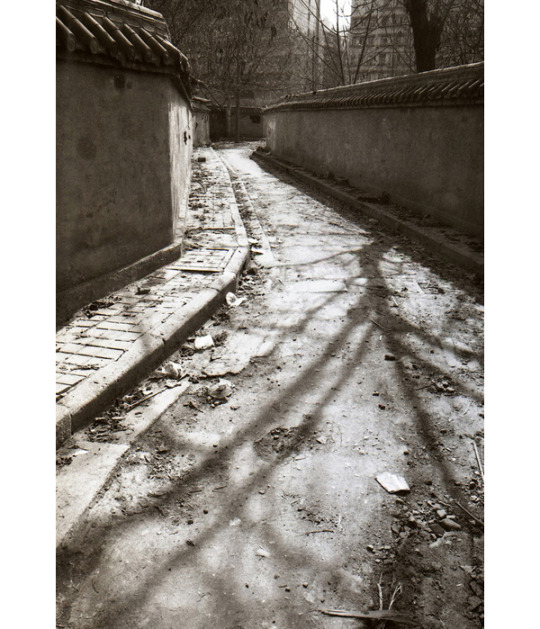
an alley in the Dacisi 大慈寺 area, Chengdu, 2006; photo by Roger Jones
Before I left Los Angeles to move to China in 2006, a work acquaintance who was interested in the country’s history told me, “You’d better go soon; China’s history has almost disappeared.”
Arriving in Chengdu, Sichuan, in the unbearably steamy summer, I nonetheless looked forward to my job teaching English at the university level. I soon realized, as I searched for traces of the city’s 2,300 year history, that the rush to modernization has virtually wiped out Chengdu’s architectural past. There are historic sites that remain, but they are mostly recreations, Disneyfied versions of China’s past for tourist consumption.
Amid the sterile, concrete monoliths that dominated central Chengdu, I was occasionally thrilled to discover small pockets of the past. Over the next several years, as ancient neighborhoods such as 水井坊 Shuijingfang and 大慈寺 Dacisi monastery disappeared under the bulldozer, I documented these areas with my camera. Both areas have now been transformed into upscale commercial and leisure zones, and are no doubt on most tourist itineraries.
大慈寺 Da Ci Si (Temple of Infinite Mercy) was once the largest monastery complex in Chengdu. Located near the downtown shopping area, its current buildings, mostly dating from the 19th or early 20th century, have been preserved. Some of the surrounding narrow lanes, in 2006, still maintained a hint of the past. However, beyond high construction walls lay nothing but the rubble of traditional buildings.

an early view of Dacisi monastery, which once housed up to 10,000 monks
While living in Chengdu I purchased a fascinating book of photographs by 周安 Zhou An, titled Chinese Folkways Memory of a City (see illustrations reproduced below). He had set out to document the everyday lives of the residents of the Dacisi area in traditional houses, with much of their activity taking place in the street or lane. The result was a book that showed “…the myriad cultural activities that take place on the streets in ancient Chengdu…. streets were the primary work and leisure places for civilians.”[1]
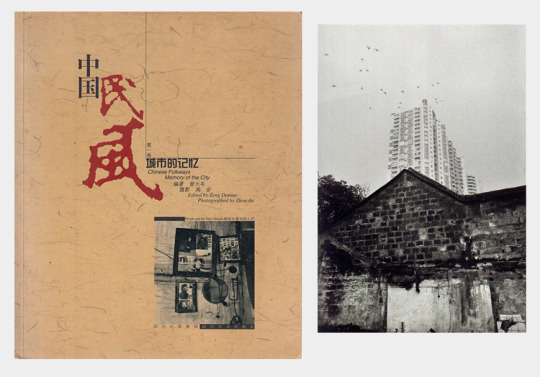
Chinese Folkways Memory of a City 城市的 记忆 Edited by 曾大毛 Zeng Damao Photographed by 周安 Zhou An 出版社:四川美术出版社 Chengdu, Sichuan, 2006

Dacisi 大慈寺, Chengdu, Sichuan. Photograph by 周安 Zhou An, Chinese Folkways Memory of a City
Here is a selection of photographs taken by 周安 Zhou An in the Dacisi area, scanned from the book pictured above. The photos document the daily life of the area before the residents were moved out, and the district was turned into a tourist shopping and leisure zone.


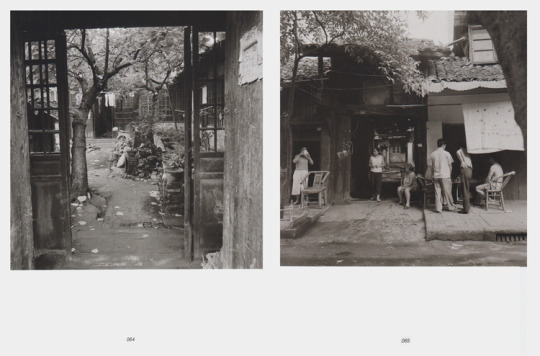



The book documents a way of life in China that has all but disappeared in large cities: a life lived low to the ground, filled with street activity, in close relationship with neighbors. It was a life replaced with market-rate housing, huge clusters of concrete apartment blocks accommodating a mass influx of people to the cities, and tourist-oriented shopping and leisure zones. “Urbanization, economic development and growing tourism are major factors fueling the transition of commercialized historic zones. However, under different initiative and preservation methods, the integrity of conserved heritages varies.” [2]
The Preface to Chinese Folkways Memory of a City outlines the clearing out of the residential area:
In June 2002, the resettlement and rehabilitation project was launched in Daci Temple area. Except those newly built and ancient building, those old houses around Daci Temple, which are of area over 250mu, would be demolished. And 25 blocks, including 4,000 houeholds and 10,000 residents, would be involved, i.e. Shamao Street, Qingyun Street, Xizigong Street, East Kangshi Street, Shuyuan Street, Est Shuncheng Street (south section) and Tianxianqiao Street, etc. The area for rehabilitation totaled up to 230,000 square meters. The Daci area would preserve its ancient architectural ensemble and build Chinese-featured low-rise architectural complex, which form the architectural style in the styles of Ming and Qing dynasties and make the area a traditional pedestrian focus of culture and commerce.
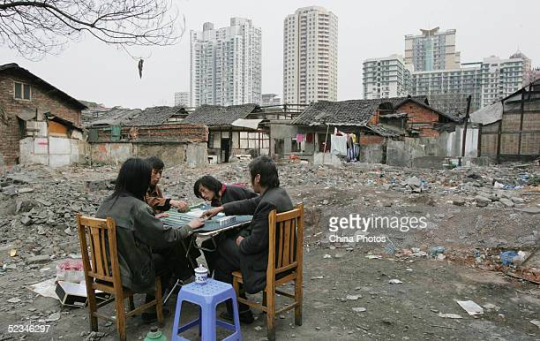
CHENGDU, CHINA - MARCH 6: (CHINA OUT) Chinese people play mahjong at a demolition site in Dacisi Area on March 6, 2005 in Chengdu of Sichuan Province, China. The Dacisi Area is an old residential zone with a lot of historic buildings dating hundreds of years back. According to the government, they are demolishing shabby houses to transform Dacisi into economic and technological development area. (Photo by China Photos/Getty Images)

Here is what has replaced the historic and once vibrant neighborhood around Dacisi: a shopping and leisure district called Taikoo Li:
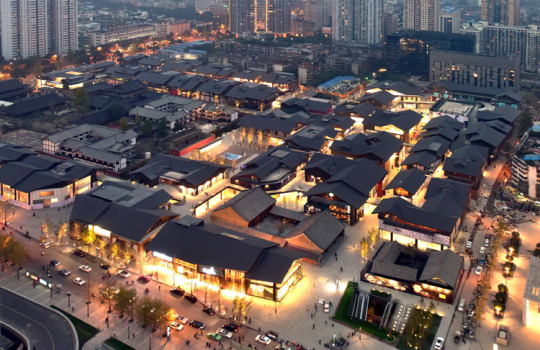

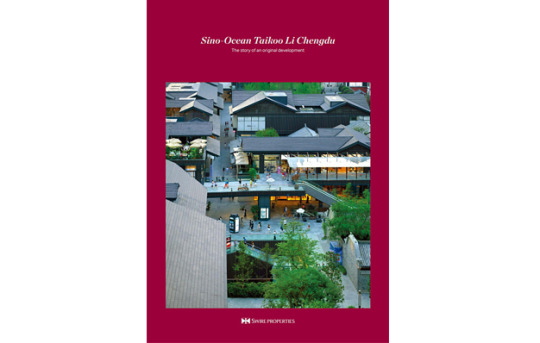
Sino-Ocean Taikoo Li Chengdu promotional brochure [click here to see brochure in PDF]

Site plan of Taikoo Li with preserved historic structures (see legend); the Dacisi monastery complex and six other buildings from the ancient area were retained. [click here to view larger size]

the preserved historic structures incorporated into the Taikoo Li complex [click here to view larger size]; preceding images are from the Taikoo Li promotional brochure linked above.

The core buildings of Dacisi monastery were preserved (see diagram above), along with six early 20th-century (late Qing dynasty) structures nearby. However, the atmosphere of a real neighborhood where people lived is gone; the "Chinese traditional style" commercial buildings create a pleasant atmosphere, but have nothing to do with Chengdu's past.
There's a term for such developments that replace China's actual history with fake or imagined history: fanggu. Describing Kuan Zhai Xiang Zi (Wide and Narrow Lanes), a prime tourist destination in Chengdu:
“It’s all counterfeit—it’s fake,” said Zhang Xianjin, a retired professor of architecture, when I met him at a nearby teahouse .... “It has no historical value...” The Wide and Narrow Lanes were a typical example of fanggu, he said, a term that literally means “imitating the old,” but has become synonymous with the fakery of historical buildings. Throughout the country, fanggu has been China’s answer to its own destructive past. With few actual relics or old buildings left to preserve, the government has instead chosen to rebuild them as they might have looked in their prime.
Beam, Christopher, “Chengdu, China Gets a Modern Makeover,” Travel + Leisure, November 10, 2015 https://www.travelandleisure.com/trip-ideas/chengdu-china-modern-makeover

Much of the Dacisi area had already been leveled before I arrived in Chengdu in 2006.[3] I took many photographs over the next several years, as what little traditional street life remained was slowly pushed aside. Here is a selection of my photographs:
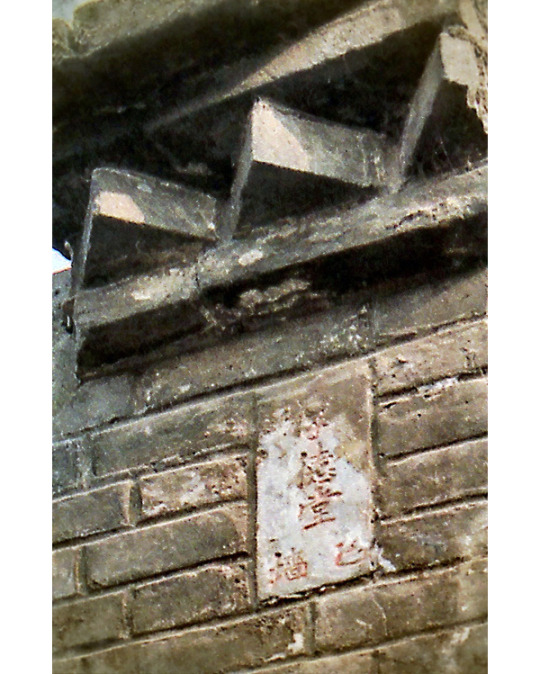
portion of an old wall with an inscribed brick
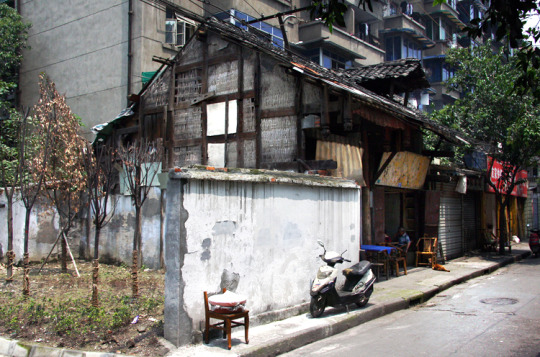
a traditional "basket weave" building in 马家巷 Majia Alley; the outer wall surface between the wood joists would have been plastered over.

looking through a broken wall, Dacisi
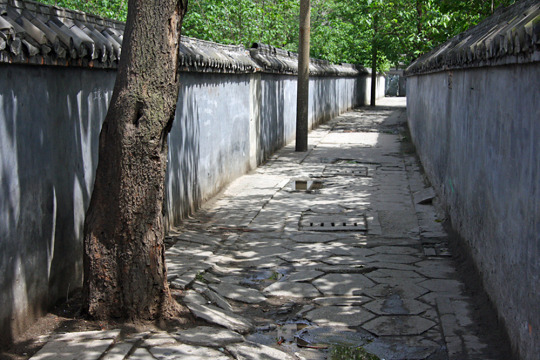
peaceful alley; this was one of my favorite spots in Chengdu; the walls actually surrounded already-demolished areas

another wall, with detail of the clay tile ornament at the top
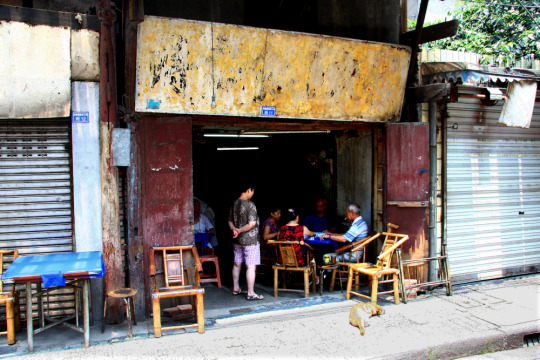
mahjong game, 马家巷 Majia Alley

the building called "Majiaxiang Ashram"

the building called "Majiaxiang Ashram"

the two buildings at 7 and 8 Zhanghuali Lane are now a high-end spa and tea house
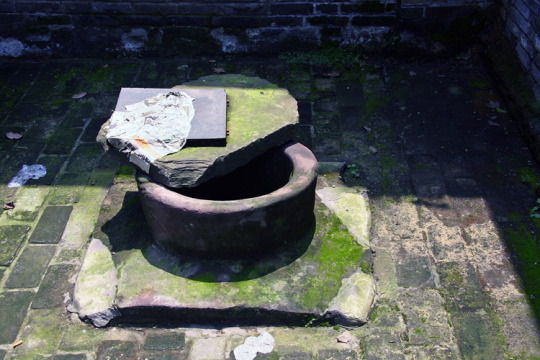
old well, Dacisi residential area

what remains: pottery shards

carved details
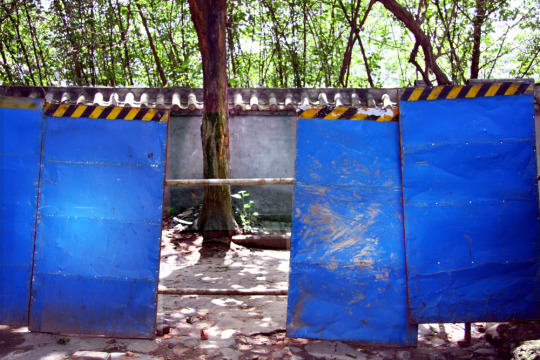
barriers

the historic wall and gateway of an old scribes’ office, the Bitieshi Building
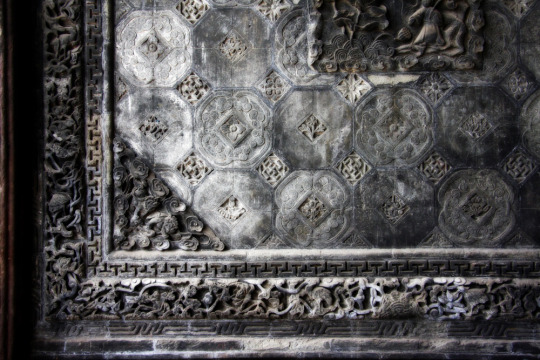
detail of tile wall decoration, Guangdong Guild Hall

Zen Tea House inside Dacisi

detail of a courtyard inside one of the preserved historic buildings

5000 years of culture is a term used often here to describe the confusion that often arises when West meets East on the Mainland, but 50 years of destruction is a term not often heard….The damage done to Han culture, the culture supposedly representing the vast majority of Mainland Chinese over the past few decades is immeasurable.
But Old Chengdu is virtually dead. The last remnants of what once a cultural capital are locked in a battle for their lives with the local government, who is more interested in a candy-coated refurbishing of the area than in the 1000 years of culture and history the neighborhood represents. And while the old city is under siege and rampant construction and development turns the city’s waterways into cesspools, the Chengdu Government wanders around in a dreamland.
The old parts of any large city in China are going or gone…. If one were to take photos of the skylines of Shenzhen, Taiyuan and Chengdu, there would be no discernible difference. And there would be no old city to offset the sterility.
Matuszak, Sascha, “The 50-Year Communist Assault on 5000 Years of Chinese Culture,” AntiWar.com https://original.antiwar.com/sascha-matuszak/2004/02/28/the-50-year-communist-assault-on-5000-years-of-chinese-culture/
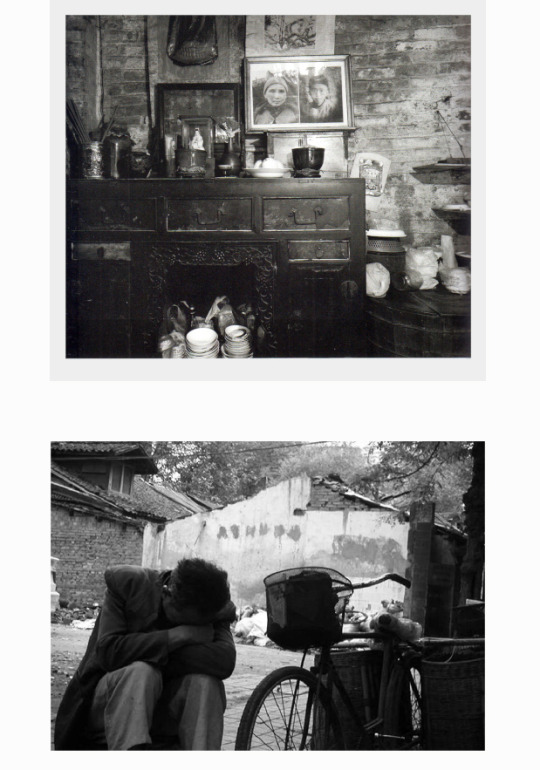
le vieux Chengdu n'est plus---xiaomifeng on Flickr

NOTES:
[1] Yang, Qianran, Success and Failure of Historic Preservation: The Cases of Chengdu, Kawagoe, and Williamsburg, senior thesis. (Brandeis University, 2016).
Yang continues, "while the visitors may be impressed by China’s modernization and rapid economic growth, they are disappointed by the missing distinctiveness of its Eastern culture" (both citations p. 4). Speaking of the Chengdu government's transformation of authentic historic areas by "degrading them into gimmicks for commerce," Yang goes on to contrast today's tourist areas in the city with the neighborhoods' original functions:
[2] Same source, p. 4.
Located in a subtropical region, this city has a climate characterized by fairly mild winters and humid summers, [and such] conditions fostered a unique street culture. In the book Street Culture in Chengdu, the author Di Wong emphasizes a combination of physical structures that lined the streets and the myriad cultural activities that take place on the streets in ancient Chengdu…. streets were the primary work and leisure places for civilians. Ordinary residents would formerly hold all sorts of communal activities on these open, easily accessible streets, which granted freedom and interaction to the public. To the performers of folk arts, the street was their stage; to hawkers, the street was their market; to children, the street was their playground; to people of Chengdu, the street was the place where they grew up.
Yang, p. 18
[3]
Most old houses in historic districts were with bad quality and lack of infrastructure, and with the time passing by, the residents in historic districts were often not the owners. This complex ownership and poor living quality made the inhabitants build new structures to accommodate demands of new generations without order. Those reasons made fire protection become a risk, and the deficiency of infrastructure become a problem.
However, this has usually been a top-down process, without participation of local residents:
As the need for local government to get profit from historic district or other cultural carriers, the regeneration is usually in a commercial way. It sometimes makes historic districts lose their own character. Furthermore, it may ignore genius loci and historical significance.
Yin, Hsiaoting, Tsinghua University, China, "Trends of Preserving Historic Districts," 48th ISOCARP Congress 2012: Issues in the Trends and Methods of Preserving Historic Districts in Today’s China: Case Study of Three Cities.
2 notes
·
View notes
Text
There are nearly 500 hardware and mould manufacturing enterprises
There are nearly 500 hardware and mould manufacturing enterprises of which 392 are scaled ones, over 100,000 practitioners, and 4 professional markets of machines, hardware and moulds. The population of Chang'an was 594,809 at the 2000 Census, making it the most populous town in China Changan has won itself the reputation of China Famous Town of Machines, Hardware and Moulds and was determined as one of the second batch industrial cluster upgrade pilots.The hardware and mould industry is mainly concentrated in Changan Town.Dongguan is a prefecture-level city in central Guangdong province, People's Republic of China an important industrial city located in the Pearl River Delta. Metal mold industry can be found in Changan, Humen, Changping, Hengli, Fenggang, Tangsha, Shijie, Guancheng; which Changan and Hengli are the leading producers. After five years fostering, the China (Changan) International Mechanism, Hardware & Mould Fair has become a professional fair with large scale and great influence on the equipment manufacturing industry in China. Dongguan borders the provincial capital of Guangzhou to the north, Huizhou to the northeast, Shenzhen to the south, and the Pearl River to bucket manufacture the westDongguan is one of the four largest mold bases in Guangdong and mainly produces plastic molds, supplemented by stamping dies.We are a professional China purchasing agent who has established good relationship with a number of mould manufacturers and suppliers in Dongguan and we can help you to purchase tooling from Changan in most efficient wayThe main scope of tooling that we help you to buy include: Plastic Injection Mould ,Stamping die, Die casting, Preform Mould ,Blowing Mould,Silicone mould, Punching Mold ,Extrusion Mould . Chang'an Town is an industrial town within the Dongguan prefecture-level city in the Pearl River Delta, in the Guangdong Province of southern China. The majority service platforms include the National Key Moulding Technology Laboratories Dongguan Experimental Center of Central China University of Science and Technology and the Mould Test Center. In 2006, with great support from the Ministry of Science and Technology of the PRC, it was upgraded to international professional fair status. In 2007 the total output value of the industry reached 9.76 billion yuan
1 note
·
View note